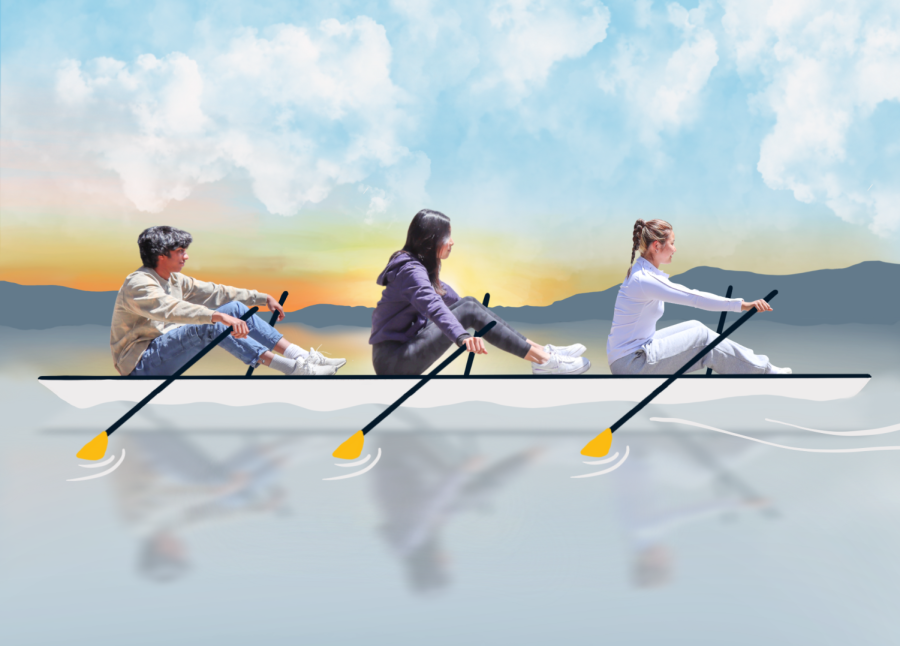Boats, oars and ergometers: Lynbrook’s rowers
Graphic illustration and photos by Susanna Tang
Training at quiet reservoirs and shorelines, rowing has become a meaningful and enjoyable sport for Chu, Kim and Venkatesh.
May 3, 2022
As the whistle sounds, rowers speed across the lake in unison, navigating along the shoreline to reach the finish line. For sophomores Vera Chu, Christie Kim and Vinay Venkatesh, the breeze in the air and the sound of oars beating against cold water is music to their ears.
It may come as a surprise that there are many rowers at Lynbrook. Training at quiet reservoirs and shorelines, rowing has become a meaningful and enjoyable sport for Chu, Kim and Venkatesh.
Kim was introduced to rowing by a family friend. Her brother tried rowing, enjoyed it and was recruited to college for rowing, so Kim followed in his footsteps at the Los Gatos Rowing Club. She tried rowing during a week-long summer camp in summer 2020, then joined the novice team for the fall season.
“Initially, I was scared about getting blisters because my brother’s hands were always absolutely shredded up and because of how intense the sport looked, but I ended up loving it,” Kim said.
Watching Instagram videos of Kim rowing with the Los Gatos Rowing Club, Chu became fascinated with the sport, and she also tried rowing in a week-long summer camp.
“There was something really exciting about being on the water and hearing it run underneath the boat,” Chu said.
She continued to learn in a novice development camp for a month after the camp. By fall 2021, she tried out for the Redwood Scullers competitive team and has been racing since then.
Venkatesh started rowing over quarantine during his freshman year, also with the Los Gatos Rowing Club. Encouraged to find outdoor sports due to the COVID-19 pandemic, he came across rowing.
“I gave it a try for like a week or so,” Venkatesh said. “The people on my team were super nice, so I ended up joining.”
Rowers enter competitions immediately after joining teams. Chu had trained in camps for a month, so she had the background and skill to get accustomed to meets. Jumping into competitive teams right away and competing at nationals as a first meet was difficult for Venkatesh, as he needed to catch up on building speed.
There are two types of competitive rowing: sweeping and sculling. Sweeping involves teams of two, four or eight, where each rower rows with one oar on one side of the boat. Sculling involves one, two, or four people and involves using two oars to generate speed.
“A benefit of sculling is that it is easier for the boat to be set because each person uses two oars, and you can easily tell whether or not the blades are even,” Chu said. “In sweeping boats, you really have to work together and complement the others in your boat so the boat doesn’t dip to one side.”
Both sweeping boats and four-person scull boats usually have a coxswain, or commander, who sits facing forward to steer the boat as rowers face the opposite direction of the boat’s motion.
Not all training happens on the water. Land days are used for rowers to build up strength for demanding rowing meets. Training involves exercises ergometers, or rowing machines, to build up arm and core strength involved in rowing.
“Land practices are days when we train on the machine, with the focus of building essential muscles and becoming a stronger athlete,” Kim said. “Our actual technique and overall stroke is improved upon during water days, when we actually go out in boats.”
With hours of training under their belt, rowers participate in regional meets, known as regattas, which are held immediately after the season starts. Fall season races are 5,000 meters long, while spring season races are 2,000 meters long. Regional meets vary depending on the number of boats and participating clubs, but they can see up to thousands of teams at each regatta. Boats are placed into categories, which take into consideration types of rowing and number of people per boat, and are further split into classes A, B, and C that compete separately.
Though rowing is a team sport, coaches assign individuals into a class A, B or C boat based on their abilities through an ergometer time trial. Competitiveness in the training room increases when preparing for meets because of boat placements, but the desire to improve has also bonded the team.
“The competitiveness is what unifies the team and strengthens the team spirit,” Venkatesh said. “At the end of the day, you guys are all going to be friends. But at practice, sometimes you just have to go as hard as you can — taking a seat from your best friend maybe.”
However, their success was not without challenges. Training alone and not seeing progress despite the work put in can be demotivating. However, as athletes strive to row on faster class A boats or establish new personal records, training is still worth it.
“You just have to get better, and you just have to do it,” Chu said, “Or else you’re going to fall down the ranks of your club — you’re gonna be at the bottom.”
Special rows like a breakfast row, where the team rows 20 kilometers and returns for breakfast, keep rowers excited for fun rowing events throughout the year. Kim’s club also celebrates personal records, which motivates her teammates and her to push themselves to row faster.
“We have a PR Bell,” Kim said. “Everyone who PRs gets to ring a bell and that’s just the thing for us.”
For athletes interested in rowing, making new friends makes the experience more enjoyable and worthwhile. In addition, patience is key when trying rowing for the first time.
“It’s awkward when you start, like getting into a tippy boat or rowing backwards and not being able to see where you’re going,” Venkatesh said. “Push through that awkward phase because once you’re able to get your stroke down, it’s a really nice feeling to be on the water.”





























































